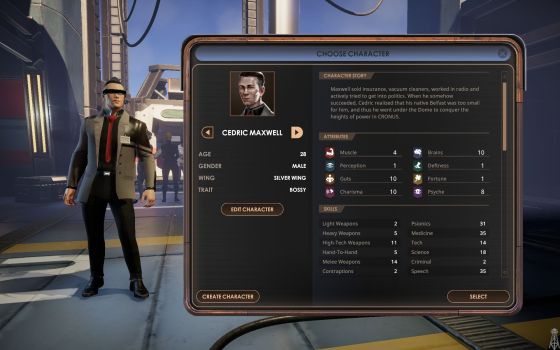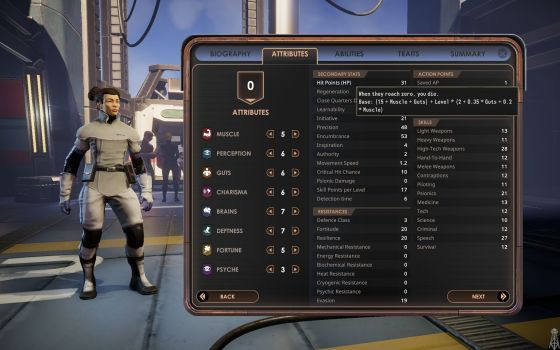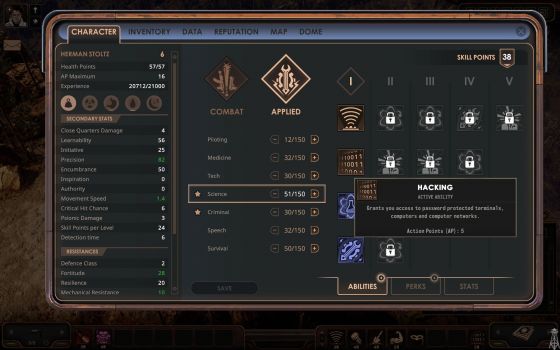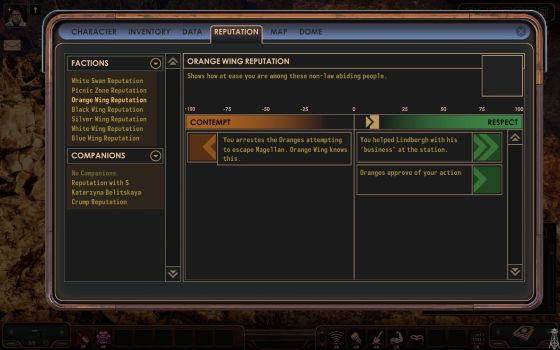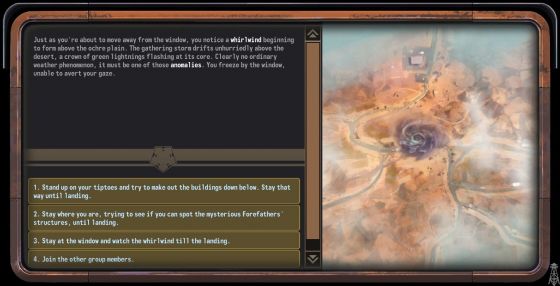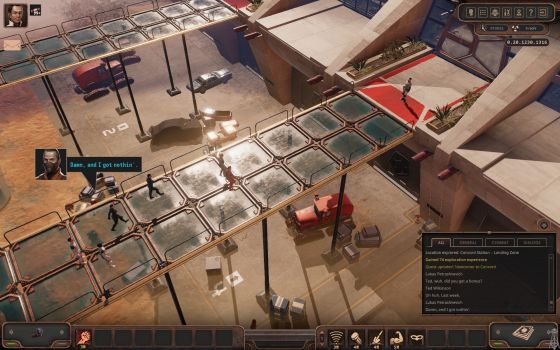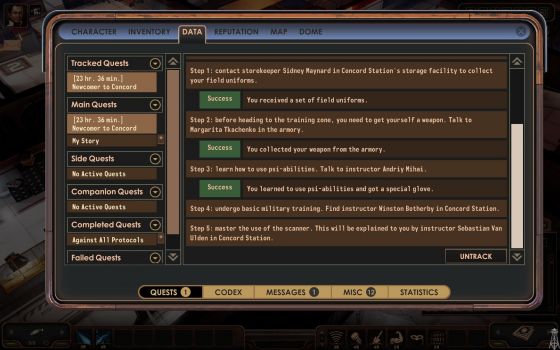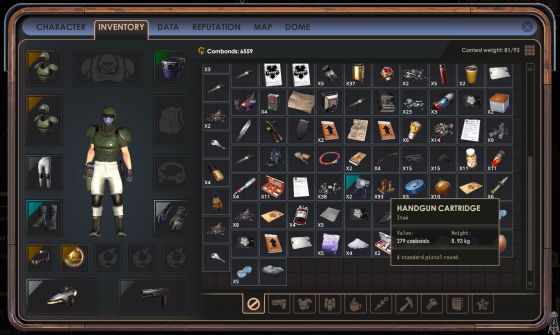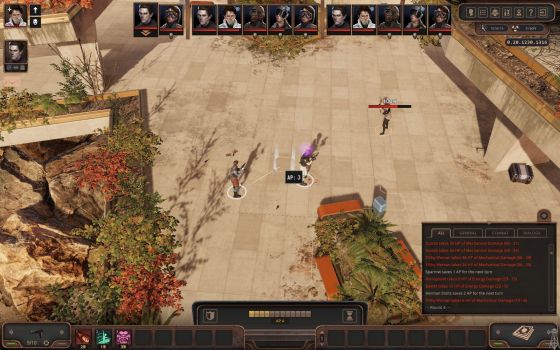Encased: A Sci-Fi Post-Apocalyptic RPG, Early Access Preview

Game Overview and a Disclaimer
Quick facts:
- story-driven 3D "isometric" CRPG (classic RPG), single-player
- turn-based combat, proprietary ruleset
- release planned in 2021, currently in Early Access (prologue & act 1)
- initial estimation was 30-40 hours for prologue, acts 1-3 and epilogue, but likely twice as long
- party with player character and up to 3 non-permanent companions who have their story and quests
- human race only, with 5 wings related to the style of job: white, silver, blue, orange and black
- separate small/medium areas, world map to travel between areas
- Windows platform, on GOG and Steam, 24.99 EUR during EA
- simultaneous release on Windows, PS 4 and Xbox One
This game is developed by Dark Crystal Games, after a successful Kickstarter campaign which started in September 2018. The goal was 86,000 EUR and they ultimately raised 105,745 EUR.
Dark Crystal Games is an independent video games company started in late 2017 in Saint-Petersburg, Russia. The early publisher was Black Tower Entertainment, but they announced in December 2020 that they would partner with Koch Media, which would allow them to spend more time to develop the games and add extra features. This is now their main publisher.
Setting
Encased is a post-apocalyptic CRPG set in an alternate 70's era, it takes place inside a giant dome that has been built by a mysterious, more advanced civilization, the Forefathers, and recently discovered in a remote desert. CRONUS, a company founded by governments for that purpose, sent people inside the dome to explore and assess the situation. There, they found new technologies and strange artefacts left by the Forefather. More people were sent, they built facilities and brought more equipment inside the dome to recover these artefacts and try to understand the technology. The player is one of the new arrivals.
The dome has a life of its own and seems to react to the recent presence of humans by spawning anomalies, and triggering other events that will quickly escalate to a potential disaster. The journey to the dome is a one-way trip for living creatures: the explorers cannot come back, so it is up to them to face those events in order to preserve the settlements and survive.
Disclaimer
This is a quick preview of the game, which is currently in Early Access and due to release later this year. I have only spent 50-60 hours in two runs through the game, and there is less communication from this developer than others like Tactical Adventures or Owlcat Games. This means I will not go into the same level of depth as my preview of Solasta. I had the impression this game was being overlooked despite being a very promising title, so I thought it would be worth sharing what little experience I had.
Character creation and companions
The adventure commences with the creation of the main character. The player can either create it from scratch or select one of the 15 pre-made characters. It is also possible to use those as a template and edit the parameters.
One of the pre-made characters
The ruleset is proprietary, but it is comparable to other classical RPGs. Each character is essentially defined by no fewer than 8 base attributes: Muscle, Perception, Guts, Charisma, Brains, Deftness, Fortune and Psyche. They are set at the creation and usually don't change much during the game, except by a few perks. The wing - the equivalent of the class, adds a bonus to the relevant attributes. Wings define the type of job the player or any NPC is specialized in, there are 5 of them:
- Black Wing are military and security forces,
- White Wing are scientists, medics and researchers,
- Blue Wing are engineers and technicians,
- Silver Wing are upper management,
- Orange Wing are ex-convicts who have exchanged their prison jumpsuits for the uniform of a CRONUS labourer.
Since many parameters are calculated from them, it is critical to choose the attributes carefully. For example, Hit Points is a formula that depends on Muscle and Guts, so is Encumbrance which specifies how much you can carry. But if you want a fighter that relies on ranged weapons, you need to pay attention to Deftness and Perception, which defines the initial value of the Light Weapon ability. The right balance must be found to get a good starting point, and being able to carry the weapon and its ammo.
Since the last update, I found that the current balance was sometimes hard to reach without sacrificing other possibilities, such as being able to pick the occasional lock or repairing devices, and thus it pushes the player to specialize a little too much. Fortunately, the developer is aware of this and has already tuned the parameters to give us a more flexible experience.
A lot of secondary stats...
As the screenshot shows, there is a lot to take in: new system, many secondary stats, perks, abilities, ... Thankfully the interface is clear and provides tooltips to give more detailed information on each parameter. An optional tutorial feature triggers on early actions and displays a pop-up with an explanation on what is about to happen, for example to help with the character creation but also later in the game. Personally I find this to be the best way to replace the good old manual that few players had the patience to read anyway.
In short, the character progresses by regularly earning skill points, for example when solving quests or discovering items and areas. Those skill points buy new abilities, such as Hacking, Point-blank Shot, Lock Picking, and so on. When levelling up, the player also earns a new perk, which modifies the base or secondary stats, or helps the progression towards specific abilities.
Abilities, 30 skill points are required to unlock the next level
The system is actually a little more complicated, since it regroups the abilities in categories and levels, but that's the main idea. There are also many, many perks to choose from, which may take some time at the beginning.
To be honest, I would have preferred a slightly simpler and more flexible system, but it is not that bad, and after a little while it becomes easier to navigate through all the possibilities to make the most of the character.
Setting and storytelling
The game is pegged as "post-apocalyptic" because of some events occurring at the issue of the prologue and which I don't want to reveal. However, in my opinion, the resulting world has some post-apocalyptic features but remains quite organized and counts a number of facilities in relatively good state, so I would rather use the term "post-cataclysm" than "post-apocalypse".
The beginning of the prologue takes place in modern facilities built by the humans inside the dome, but the player soon gets the opportunity to travel between outposts and settlements, discovering other types of environments like desert wilderness, shanky towns, bunkers, and so on.
If you don't pay attention, your reputation will precede you...
The wings we mentioned earlier are not only classes for the characters, they are factions too. But it doesn't stop there; later on in the game several other factions come to existence. The player's character earns a reputation with each of those factions and with each companion; this may sometimes have significant consequences. For example, I started striking doubtful deals with the Oranges, and one of my companions told me that he was feeling uneasy about that. I didn't pay enough attention so he finally got very upset and left me on the spot. Just like that.
Without giving away too much, your adventure starts on the elevator that brings you inside the dome, where you get a comfortable introductory tutorial. It is very well done and quite fun to go through, the people you meet are usually rather caricatural of their trade, like the stiff impatient receptionist, the rookie manager who tries to organize things but ends up making a mess of it or the passionate technician eager to teach you some cool tricks.
Don't test Dean's patience
One strong point of this game is the dialogs. Each NPC can be talked to, and many of them have a definite personality and multiple dialog paths that are often very enjoyable. Some lines are only available to some factions, or with specific abilities, but I frequently found several alternative ways to solve any given problem. It is one of these games where you can either fight or talk your way out of a difficult situation, although the choice may depend on your stats.
Many NPCs also help the player puzzle out the situation, by explaining what they know on the history of the dome, how CRONUS - that company founded by the world's most powerful governments and which is in charge of the exploitation of the dome, is organized and really ticks.
Now and then an event or a situation is presented as a series of slides with options, usually to emphasize the narrative or to illustrate it with stylized images. It is very reminiscent of the "story book" presentation we find in other CPRGs like Pathfinder and Pillars of Eternity.
Narrative has several formats, here the "slide presentation"
General presentation
My overall impression of the presentation is very positive. The graphics are pretty good, it is possible to pan and rotate the camera, and zoom in and out enough to get a good view of the surroundings or see enough details. The game uses the traditional 3D down view at a constant angle (still often called "isometric"), with upper floors disappearing so your characters are always visible. The animations are fluid and I haven't encountered any performance problem, even when I was running the game on my old computer (i7 4770K at 3.5 GHz, GTX 980 Ti). The only reproach I could make regarding the graphics is the drab and brownish style of the UI elements. It is very 70's in a way, and this is a common trait of many post-apocalyptic games, so maybe it's unfair to criticize this choice of colours.
Graphics are pretty good
The music is OK, if a bit dull in some areas; it isn't really that memorable to be honest. I usually turn it quite low in games so that doesn't bother me. The sound effects, on the other hand, are convincing and give a good feedback. There is little to no voice acting in the current version so I cannot comment on that.
The interface is usually fine, at the exception of the companions. It is not possible to control them much, not even to ask them to stop following you for a while, so when the player has to go through a dangerous area like a mine field or radiations, the companions will very likely get hurt and there is no avoiding it except sending them away. I also find them very annoying in small areas, where they tend to move in your way all the time, causing your character to stop, or blocking the path to objects or containers you want to check. I mentioned that on Discord and the developers told me this would be improved and that the player would have more control over the companions in the final release.
Likewise, it is not possible to switch to another character from the inventory or the character sheet, the UI currently lacks flexibility and is a bit confusing, but that has already been improved and I saw a video showing that most of those issues were solved. They are minor points though, and I'm mostly pointing them out to illustrate that the developer is listening to the feedback and addressing the issues.
Otherwise, the UI is generally well-organized, clear and readable. Rather than overcrowding it with a lot of details, the interface relies on tooltips that the user can read to get more information. This is also used in the narrative for pieces of lore, as in other games like Pillars of Eternity, Pathfinder or Divinity: Original Sin 2.
Quests
Another strong point of the game is the quality of the quests. They are divided into main quests, side quests and companion quests.
The main quests in the Early Access already have many of the ingredients that make up a great game. They are quite varied, they may make you travel all over the place to acquire key items or put plans into motion, they may require you to solve puzzles, explore a distant outpost to assess the situation and maybe resolve unexpected issues. Sometimes you receive a first general list of tasks, for which you have to meet other NPCs who know more about specific points and give you further tasks to address them. And while some NPCs are dead serious, others are completely out there and must be dealt with accordingly. It's certainly not boring!
Side quests are usually interesting and very varied too, they are about NPCs you encounter in the course of a main quest, and who have their own problems or agenda. Sometimes taking a side quest has an impact on the reputation, sometimes the way you solve the quest has an impact too. I found fewer companion quests but there are a few areas I haven't explored yet, and Dark Crystal Games is still adding content. In one case I had a companion for the short duration of their own quest, after which we parted ways, which was unexpected. So we may see a few surprises there too.
I haven't seen timed quest, except when I started a quick new game for the sake of this preview. There, I noticed a time indication for the "Newcomer to Concord" 101 quest, as you can witness in the screenshot below. That was new to me and made me wonder if timed quests would make their appearance in the final game, but they said it wouldn't be the case. Some quests require to meet someone at a more or less precise time of the day, or to wait for a while before it can proceed further, so time is a component of the game - and by the way, there is a day/night cycle in the game! Some abilities depend on it, giving you more advantage during the day or the night.
The quest log: weird choice of colours, but very practical
The quest journal does its job well, reminding you of the minimum information relevant to the tasks at hand. It also keeps track of email messages - very few at the moment, and a codex keeps the names of the important encounters, and the artefacts you have discovered.
Another good surprise is that there are no quest pointers in this game, not on the local map, not on the world map, and of course not in the isometric view either. In some rare cases, the NPC marks down a location on the map, but that's it. It didn't make the game any harder, though a few times I had to look for someone at different places. Usually the NPCs don't move much, so it is hardly a problem.
The pointer-free world map (very early in the game to avoid spoilers)
Inventory, bartering and crafting
I will only mention that there is currently a per-character inventory, but it will change to a shared inventory in the final version. It quickly becomes encumbered and unless the main character has a high strength, items have to be sorted out regularly. I'm wondering how they will proceed with the shared inventory, perhaps with shared statistics as well? What if a companion leaves, will we have to drop items? Wait and see.
Several types of crafting are implemented, for food, ammo, DIY items and so on. They are enabled by using the corresponding workbench; you can find them at multiple locations in the dome.
Your typical messy inventory
Each NPC can be bartered with, though many of them don't have any money so you have to spot the interesting NPCs to sell looted items, and those who have interesting gear or items that may help with the quests. Overall, it is well balanced, the player can get adequate equipment and I didn't feel like having too much or too little money.
Combat
Combat is turn-based with Action Points
Combat is another important element of the game. It is turn-based with action points (AP); the player plays the main character and the companions, if any is present in the party. AP can be used to move, shoot, strike, reload weapons, go through the inventory, or perform other abilities like healing. The remaining AP can also be used to boost the character's defence in preparation for the enemy's actions, or they can be partially saved for the next turn.
There are many different weapons, each often having several marks (or versions). Sometimes they can be upgraded by crafting, and must be maintained to avoid frequent jamming, although I haven't had any problem so far. They are several categories that come with corresponding abilities: melee, light weapons, heavy weapons and high-tech, but characters can also use hand-to-hand combat.
I will not go into further details, but there is more to say on combat and it is a well-developed feature in this game. Yet it is often possible to avoid it and defusing awkward situations with a little diplomacy, provided you have the necessary abilities. Be aware that if you build the ultimate fighter, you will not have enough points left to develop much in terms of soft skills, but since it is clearly not your objective, it shouldn't matter much.
Finally, you can select the game difficulty level, this helps with the combat but also with other constraints like the maximum carry weight and so on. You can change that during the game, which is a nice touch.
Will you chicken out of this one?
Game Status
They are still adding content to the game, tuning and polishing it, so we should expect many changes in the final version, including voice acting. At the moment, and because of this new partnership in fact, they are very shy about giving a status update and any definite release date. The new partnership announcement and the postponement got them quite some criticism, which also explains their reluctance to commit to any target date just yet. This criticism by fans who are getting impatient is the main reason why the recent review scores are pretty bad on Steam, it has nothing to do with the game itself; actually, the all-time score average is very positive.
This game passed the ultimate RPG test. Functional lavatory: check!
There won't be any game update until the final release, and from all the bits of news and discussions on Steam and Discord, I have little doubt that they are very close to finishing the content, and that it will be a very good indie game. The current state of the EA is quite good, there are a few bugs and the UI is not perfect, but nothing serious, this is already in better shape than other "finished" games.
Conclusion
This game came as a very pleasant surprise! I had heard very little about them before, and they don't release a lot of news so there is less transparency than some EA games like Solasta, but it's about on par with Baldur's Gate 3 in terms of updates and news.
This is a Russian developer, and the community is more active on Discord in the Russian-speaking channels, the international ones are quieter. They answer to questions though, both there and in the Steam forums, I would even say that so far they have been quite responsive, which is always a good sign.
The game is pretty solid and I was impressed by the amount of dialogs, even if they are not pages-long they still give a lot of spoken and narrative content, and often provide the player with many choices. To me they just hit the soft spot. I was also favourably impressed by the quests and the flexibility to approach the problems. I don't know yet whether the main quests will feature heavy choices and consequences, or multiple endings, but given the small size of the team, the budget and the fact this will be voice-acted, I would say that it is unlikely. Regardless, there is enough replay value thanks to the amount of abilities, perks and the different ways to go through dialogs and solve quests.
The graphics, the sounds, the animation and the game mechanics are very good and stable. Playing the game quickly gives the reassuring impression that it has been made by professionals.
On the side of issues worth keeping an eye on, there were a few awkward decisions in the UI implementation and the lack of control over the companions, but they are being addressed. Another concern is the remaining content, which will only be released in the final game and will not benefit from the same level of scrutiny than the EA content. Added to the pressure to release a first game, the extra features and the new publisher, we have to hope they don't rush it without proper testing and fixing.
If I had to name a game similar to Encased, I would say it feels a little bit like a more ambitious Atom RPG, in more polished, less harsh in difficulty and without the desperate atmosphere - the "post-cataclysm" vs "post-apocalypse" nuance mentioned earlier. I didn't go very far in Atom RPG so don't take my word as gospel, it's just an impression and I'd be curious to read other opinions.
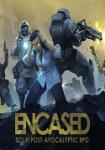
Information about
EncasedDeveloper: Dark Crystal Games
SP/MP: Single-player
Setting: Post-Apoc
Genre: RPG
Combat: Turn-based
Play-time: 40-60 hours
Voice-acting: Partially voiced
Regions & platforms
Internet
· Homepage
· Platform: PC
· Released: 2021-09-07
· Publisher: Prime Matter
More information


